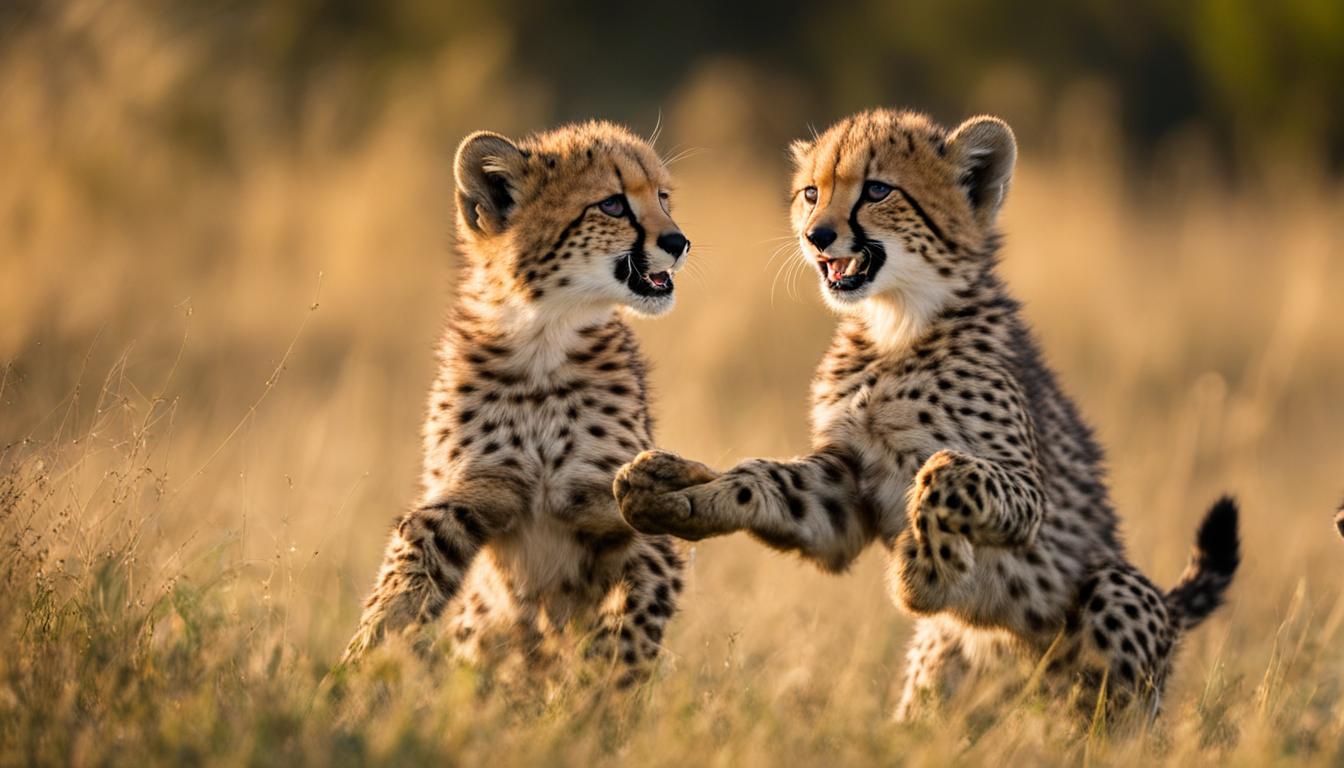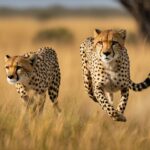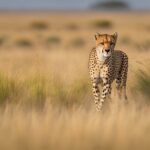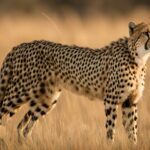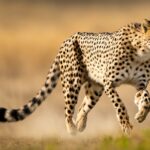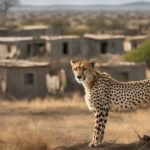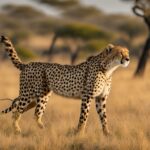Welcome to our article on the fascinating growth and development of cheetah cubs. If you’ve ever wondered about the behavior, care, diet, and conservation of these adorable baby cheetahs, then you’re in the right place. In this article, we’ll explore the incredible journey of cheetah cubs, from birth to adulthood. Get ready to discover interesting facts, learn about their adaptations, and understand the importance of raising and conserving cheetah cubs. But first, let’s delve into the early stages of their development. Take a look at the adorable image below to get a glimpse of these remarkable creatures in action.
The Physical Characteristics of Cheetah Cubs
When cheetah cubs are born, they weigh between 8.5 and 15 ounces and are completely blind and helpless. One of their most noticeable physical features is a thick silvery-grey mantle on their back, which helps them blend in with the environment and mimic the appearance of an aggressive honey badger. This camouflage serves as a deterrent to potential predators such as lions, hyenas, and eagles.
As cheetah cubs grow, their mantle disappears around three months of age, and their distinct black tear stripes become more prominent. These tear stripes are unique to cheetahs and help to reduce glare from the sun, allowing them to focus on their prey during high-speed chases. Cheetahs have a thin frame with a narrow waist, which helps with agility and maneuverability. Their long legs provide a longer stride and contribute to their exceptional speed, allowing them to reach speeds of up to 70 miles per hour in just a few seconds.
The Physical Characteristics of Cheetah Cubs
The physical characteristics of cheetah cubs are not only fascinating but also essential for their survival in the wild. Their camouflage, tear stripes, body structure, and long legs all play a crucial role in their ability to hunt and evade predators. Understanding these physical adaptations gives us a deeper appreciation for the incredible abilities of cheetah cubs.
| Physical Characteristics | Description |
|---|---|
| Mantle | A thick silvery-grey mantle on their back, providing camouflage and mimicking the appearance of an aggressive honey badger. |
| Tear Stripes | Distinct black tear stripes that become more prominent as they grow, reducing glare and improving focus during high-speed chases. |
| Body Structure | A thin frame with a narrow waist, contributing to agility and maneuverability. |
| Long Legs | Long legs that provide a longer stride and contribute to their exceptional speed. |
The Physical Characteristics of Cheetah Cubs
In summary, cheetah cubs possess unique physical adaptations that enable them to survive and thrive in their environment. From their camouflage mantle to their black tear stripes and slender body structure, each characteristic serves a specific purpose in their hunting and evasion tactics. These remarkable features are a testament to the incredible capabilities of cheetah cubs as they navigate the challenges of the wild.
The Development of Cheetah Cubs
Cheetah cubs go through a fascinating journey of development from birth to adulthood. Here are the key milestones they reach along the way:
- Seclusion and Dependency: For the first six to eight weeks of their lives, cheetah cubs remain secluded in a nest, carefully moved by their mother to avoid predators. During this time, they depend on their mother for warmth, protection, and nourishment.
- Following Their Mother: At around six weeks of age, the cubs start to accompany their mother on her hunting trips. This is when they begin learning essential life skills and exploring their environment. They observe their mother’s hunting techniques and gradually start to mimic them as they grow older.
- Playfulness and Skill Development: Between four to six months of age, cheetah cubs become more active and playful. They engage in various activities like climbing trees and chasing small prey, which helps them develop their hunting skills. This playful phase is crucial for their physical and mental development.
- Becoming Independent: Around 18 months of age, cheetah cubs start to separate from their mother and become more independent. While they are not fully capable of hunting on their own yet, they continue to refine their skills and gradually transition into adulthood.
Throughout their journey, cheetah cubs rely on their mother’s guidance and teaching to navigate the challenges of the wild. It is through this process of development that they acquire the necessary skills and knowledge to survive in their environment.
The Development of Cheetah Cubs
| Development Stage | Description |
|---|---|
| Seclusion and Dependency | For the first six to eight weeks, cheetah cubs stay secluded in a nest, moved by their mother to avoid predators. |
| Following Their Mother | At around six weeks of age, cubs start accompanying their mother on hunting trips, learning important life skills. |
| Playfulness and Skill Development | Between four to six months, cheetah cubs become more active, engaging in play that contributes to their physical and mental development. |
| Becoming Independent | At 18 months, cheetah cubs start to separate from their mother and transition into adulthood. |
The development of cheetah cubs is a remarkable process, filled with growth, learning, and exploration. It is through their experiences and interactions with their mother that they acquire the skills necessary for survival in the wild.
Cheetah Cub Behavior and Social Structure
Understanding the behavior and social structure of cheetah cubs is key to appreciating the fascinating lives of these young predators. From their interactions with siblings to their learning experiences, cheetah cubs exhibit various behaviors that shape their development and contribute to their survival in the wild.
Cheetah cubs, particularly males, form coalitions with their siblings. These coalitions consist of a group of cheetahs that hunt and defend territories together. This social structure provides numerous advantages, such as increased hunting success and protection against predators. Female cheetahs, on the other hand, tend to be more solitary, although they may pair up with other mothers and share dens. However, their home ranges often overlap with multiple male territories.
“Female cheetahs have larger home ranges that overlap with multiple male territories.”
As cheetah cubs grow, they learn important hunting and survival skills through play and observation of their mother. Cubs engage in playful behaviors, such as chasing and wrestling with each other, which helps them develop their agility, coordination, and hunting techniques. Through these playful interactions, they learn how to stalk, pounce, and bring down prey effectively.
| Behavior | Description |
|---|---|
| Playfulness | Cheetah cubs engage in playful behaviors, such as chasing and wrestling with each other, which helps them develop their agility and hunting techniques. |
| Observation | Cubs learn by observing their mother during hunting expeditions, acquiring essential skills and strategies for hunting success. |
| Coalition Formation | Male cheetah cubs form coalitions with their siblings, providing better protection and hunting opportunities. |
By understanding the behavior and social structure of cheetah cubs, researchers and conservationists can implement strategies to protect these vulnerable predators. Conservation efforts aim to preserve their habitats, reduce human-wildlife conflicts, and promote genetic diversity through captive breeding programs. By safeguarding the future of cheetah cubs, we ensure the continued existence of these magnificent creatures in our ecosystem.
Cheetah Cub Diet and Feeding
Understanding the diet and feeding habits of cheetah cubs is crucial for their survival. While they start nursing from their mother for up to three months, they are introduced to meat from three weeks old. This early introduction to solid food helps them adapt to a carnivorous diet. As they grow older, cheetah cubs gradually transition to a diet of small antelopes, which are their primary prey in the wild.
At around six weeks of age, cheetah cubs start accompanying their mother on hunts, learning valuable hunting and feeding skills. It is during these hunting expeditions that they observe and mimic their mother’s hunting techniques. This hands-on experience plays a vital role in their development as proficient hunters in the future.
| Dietary Habits | Feeding Behavior |
|---|---|
| Primary diet: Small antelopes | Accompany mother on hunts |
| Introduced to meat at three weeks old | Observe and mimic mother’s hunting techniques |
| Nursing from mother up to three months old | Gradually transition to solid food |
While learning to hunt is a critical survival skill, cheetah cubs face a high mortality rate during their first few months of life. Their vulnerability to predation by larger predators such as lions and hyenas poses a significant risk. The guidance and protection of their mother during hunting expeditions are crucial for their safety, as she teaches them how to navigate the risks associated with hunting and feeding.
In summary, cheetah cubs start their journey to becoming proficient hunters by nursing from their mother and gradually transitioning to a diet of small antelopes. Through accompanying their mother on hunts and observing her techniques, they develop the necessary skills and feeding behaviors to thrive in the wild.
The Transition to Adulthood for Cheetah Cubs
As cheetah cubs reach around 18 months of age, they begin their journey towards adulthood and independence. While they might not be fully adept at hunting on their own just yet, this is a critical time for them to continue developing their hunting skills under the guidance of their mother. Female cheetahs, upon reaching three years of age, leave their mothers and embark on a solitary life, exploring their own territories. On the other hand, male cheetahs often choose to remain together in coalitions for life, forming a strong bond and defending their territories as a group.
For cheetah cubs, the transition to adulthood involves not only mastering their hunting skills but also adapting to the challenges that come with a life in the wild. During this phase, they learn to navigate their surroundings, establish their own territories, and compete with other cheetahs for resources. It is a time of great exploration and growth as they establish their roles in the ecosystem.
Becoming an adult cheetah requires patience, resilience, and adaptability. These traits are honed through experiences and interactions with their environment. Each successful hunt and interaction with other cheetahs contributes to their development and ensures a higher chance of survival in the wild. The transition to adulthood is a crucial stage in the life of a cheetah cub, setting the foundation for their future as they navigate the challenges and opportunities of the natural world.
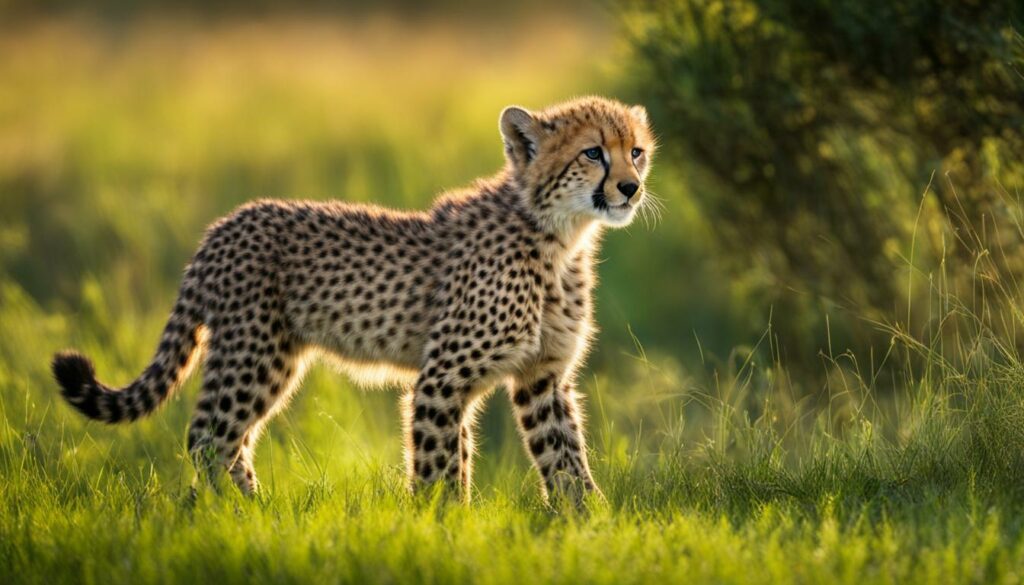
Overall, the transition to adulthood for cheetah cubs marks a significant phase in their lives. It is a time of exploration, learning, and the development of essential skills. As they gradually separate from their mothers and embrace independence, they face the challenges of surviving on their own, establishing territories, and navigating the intricacies of the wild. Whether they choose a solitary path or form coalitions with other cheetahs, the transition to adulthood is a critical period that shapes their future as they strive to thrive in their natural habitat.
The Conservation of Cheetah Cubs
Cheetah cubs face numerous threats to their survival, making their conservation a crucial endeavor. Habitat loss, poaching, and conflicts with humans are some of the significant challenges that impact the population of cheetahs and their cubs. Moreover, the small gene pool resulting from centuries of inbreeding has led to reduced genetic diversity among cheetahs. To address these issues, various organizations and sanctuaries are actively involved in conservation efforts.
The primary focus of cheetah cub conservation is the protection of their habitats. Preserving large areas of suitable habitat ensures that cheetahs have enough space to roam, hunt, and raise their cubs. Additionally, efforts are made to minimize conflicts between cheetahs and humans. This includes implementing measures to prevent livestock predation, such as providing local communities with alternative livelihoods and promoting coexistence between humans and cheetahs.
Another essential aspect of cheetah cub conservation is the establishment of captive breeding programs. These programs aim to maintain genetic diversity and prevent inbreeding depression within the captive cheetah population. By carefully managing breeding pairs and reintroducing captive-born cheetahs into the wild, conservationists can strengthen the overall population and ensure the long-term survival of cheetahs and their cubs.
| Threats to Cheetah Cub Survival | Conservation Efforts |
|---|---|
| Habitat loss | Preserving large areas of suitable habitat |
| Poaching | Implementing measures to prevent poaching and illegal trade |
| Conflicts with humans | Minimizing human-wildlife conflicts through education and community-based initiatives |
| Reduced genetic diversity | Establishing captive breeding programs to maintain genetic diversity |
Cheetah cubs are a vulnerable and irreplaceable part of our natural heritage. Through concerted conservation efforts, we can ensure that these magnificent creatures continue to roam the wild, contributing to the biodiversity of our planet for generations to come.
Conclusion
Cheetah cubs go through a remarkable journey of growth and development, facing numerous challenges and dangers along the way. From their birth to adulthood, these young cubs navigate the intricacies of their environment under the guidance of their mothers. They learn vital skills for survival, such as hunting and navigating their territory, which are crucial for their future well-being.
However, the survival of cheetah cubs is threatened by factors such as habitat loss, poaching, and conflicts with humans. The conservation of these magnificent creatures is essential to ensure their long-term survival in the wild. Efforts are being made to protect cheetah habitats, reduce human-wildlife conflicts, and maintain genetic diversity through captive breeding programs.
By supporting conservation initiatives and raising awareness about the importance of cheetah cub growth and development, we can contribute to the preservation of these incredible animals. Together, we can create a brighter future for cheetah cubs, where they can thrive and continue to captivate us with their beauty and agility.
How does the birthing process and raising of cheetah cubs contribute to their growth and development?
The process of cheetah birth is a critical stage in the growth and development of cheetah cubs. The birthing process and the subsequent raising of the cubs by their mother are essential for their survival and well-being. Through this process, the cubs are able to develop the necessary skills and behaviors needed for their eventual independence in the wild.
FAQ
What are the different stages in the life cycle of a cheetah cub?
Cheetah cubs go through three stages in their life cycle: cub (birth to 18 months), adolescence (18 to 24 months), and adult life (24 months and on).
How long is the gestation period for cheetahs?
The gestation period for cheetahs is around 93 days.
How many cubs are typically born in a cheetah litter?
Litters can range in size from one or two cubs up to six cubs.
What is the mortality rate for cheetah cubs in protected areas?
Cub mortality can be as high as 90% in protected areas due to the proximity of large predators.
What is the average lifespan of cheetahs in the wild?
Cheetahs in the wild have an average lifespan of 10-12 years.
What is the difference in lifespan between male and female cheetahs?
Males have a slightly shorter lifespan due to territorial conflicts.
What is a cheetah cub’s weight at birth?
Cheetah cubs weigh between 8.5 and 15 ounces at birth.
How do cheetah cubs protect themselves from predators?
Cheetah cubs have a thick silvery-grey mantle on their back, which helps camouflage them and mimic the appearance of an aggressive honey badger.
At what age do cheetah cubs start following their mother?
Cheetah cubs start following their mother on her daily travels at about six weeks of age.
When do cheetah cubs become more active and playful?
Cheetah cubs become more active and playful at around four to six months of age.
Do cheetah cubs hunt with their mother?
Yes, cheetah cubs accompany their mother on hunts starting from six weeks of age.
What do cheetah cubs eat?
Cheetah cubs start nursing from their mother for up to three months but are introduced to meat from three weeks old. They gradually transition to a diet of small antelopes as they grow older.
At what age do cheetah cubs become independent?
Cheetah cubs start to become independent around 18 months of age.
How do male cheetahs socialize?
Male cheetah cubs form coalitions with their siblings, known as a group of cheetahs that hunt and defend territories together.
What is the main threat to cheetah cubs in the wild?
Adult mortality is a significant factor affecting the wild cheetah population.
How can cheetah cubs be protected?
Conservation efforts focus on protecting cheetah habitats, reducing human-wildlife conflicts, and implementing captive breeding programs to maintain genetic diversity.

